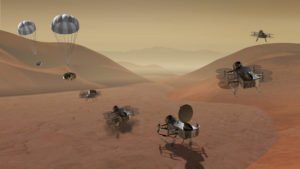Drones are all over the place – floating over farm fields, diving into catastrophe scenes, exploring a probably life-harboring moon of Saturn (file scratch!). Wait. What? No, you’re not struggling a post-holiday meals hangover – NASA might very nicely ship a drone to Titan, Saturn’s largest moon.
Last week, the American house company shortlisted a drone idea to launch a robotic Saturn mission within the mid-2020s. Dragonfly, a UAV rotorcraft, will discover the frozen moon looking for life. With an lively ocean beneath its icy crust, Titan could also be researchers’ greatest hope for discovering extraterrestrial life in our photo voltaic system (albeit possible bacterial).
“This is a giant leap forward in developing our next bold mission of science discovery,” mentioned NASA mission chief Thomas Zurbuchen mentioned. “These are tantalizing investigations that seek to answer some of the biggest questions in our solar system today.”
The challenge is a part of NASA’s multi-phase New Frontiers Program and contains six mission themes: “comet surface sample return, lunar south pole-Aitken Basin sample return, ocean worlds (like Titan), a Saturn probe, Trojan asteroid tour and rendezvous, and Venus explorer.”
NASA officers describe New Frontiers as a “series of principal investigator-led planetary science investigations that fall under a development cost cap of approximately $850 million.” Not a foul deal for below a billion.
The challenge stretches again to 2014 when NASA introduced the idea because the “Titan Aerial Daughtercraft.” The 22-pound drone would detach from a balloon or lander to “acquire close-up, high resolution imagery and mapping data of the surface, land at multiple locations to acquire microscopic imagery and samples of solid and liquid material, return the samples to the mothership for analysis, and recharge … on the mothership to enable multiple sorties.”
“Titan is the richest laboratory in the solar system for studying prebiotic chemistry, which makes studying its chemistry from the surface and in the atmosphere one of the most important objectives in planetary science,” a 2014 NASA report said.
Back on earth, NASA has already constructed a stable monitor file in terrestrial drone analysis. This previous summer time, a trio of company groups garnered permission to launch feasibility research regarding Unmanned Aircraft Systems. Part of NASA’s Convergent Aeronautics Solutions challenge, the research will give attention to drone security and flight administration.
 Unmanned Aerial Vehicle The latest drone news
Unmanned Aerial Vehicle The latest drone news




